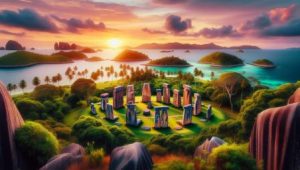Exploring the Timeless Wonders: A Journey Through Palau’s Cultural Heritage Sites
Welcome to Palau Explorer, where we embark on a journey through the remarkable cultural heritage sites of Palau. Nestled in the heart of the Pacific, Palau boasts a rich tapestry of history and tradition, manifesting in its stunning historical landmarks and monuments. As we delve into the essence of this enchanting archipelago, prepare to be transported through time and culture in an experience that promises to be as enlightening as it is breathtaking.
Babeldaob Island’s Ancient Stone Monoliths
The mysteries of Palau begin on the largest island of Babeldaob, home to enigmatic stone monoliths that have stood the test of time. These megaliths, which resemble Easter Island’s Moai, offer a glimpse into the early Palauan society. Though their origins remain shrouded in mystery, they are believed to be remnants of a complex and sophisticated community. Visitors can stroll through the site, pondering the immense effort it would have taken to erect these colossal structures. Theories about their purpose include everything from a grand meeting place for village chiefs to an astronomical observatory.
Badrulchau Stone Monoliths
As part of the exploration, we cannot overlook the Badrulchau stone monoliths. Situated in an open field, the site encompasses 37 basalt megaliths, some of which weigh up to several tons. Dating back to around 161 AD, as suggested by archaeological research, the site offers more than just historical intrigue; it is a place of peace and natural beauty, with the surrounding area’s vibrant flora and fauna setting a picturesque scene.
- The largest of the monoliths stands at an impressive height, commanding respect and admiration.
- Local legends speak of the monoliths being carried by giants, offering a cultural mythos to the experience.
- Surrounding stone platforms suggest the area was once used for communal gatherings.
Yapese Stone Money of Palau
The island of Palau also sheds light on a unique cultural aspect of Micronesia – the stone money of Yap. Although these large, circular stones originated from the neighboring island of Yap, some found their way to Palau, indicating a rich history of trade and interaction between the islands. The stone discs, known as Rai, are scattered across Palau, symbolizing wealth and social status. Their sheer size and the arduous journey they undertook from Yap to Palau speak volumes about the value placed on them by ancient Micronesians.
Historical Significance
The Rai stones hold great historical significance as they demonstrate the complex economic and social networks that existed among the islands of the Pacific. The ingenuity of these early people in creating a form of currency that, while immobile, served as a testament to social ties and obligations, is nothing short of remarkable.
World War II Relics
The remnants of World War II offer a somber contrast to the ancient history of Palau. The islands served as battlegrounds during the conflict, and today, they are home to a number of historical wreck sites, both on land and underwater. These sites include sunken ships, planes, and remnants of military installations, silently narrating the tumultuous period of the 20th century. For history buffs, these artifacts serve as a direct connection to the past, allowing for a deeper understanding of the global events that shaped our world.
Palau’s cultural heritage is as diverse as it is enchanting. From the ancient stone monoliths to the echoes of World War II, Palau Explorer offers an opportunity to connect with the past in a truly profound way. We invite you to join us as we uncover the secrets and stories embedded in these timeless wonders, each site a chapter in the larger narrative of human history. This is more than just a tour; it’s an expedition into the heart of culture, tradition, and the enduring spirit of Palau.
